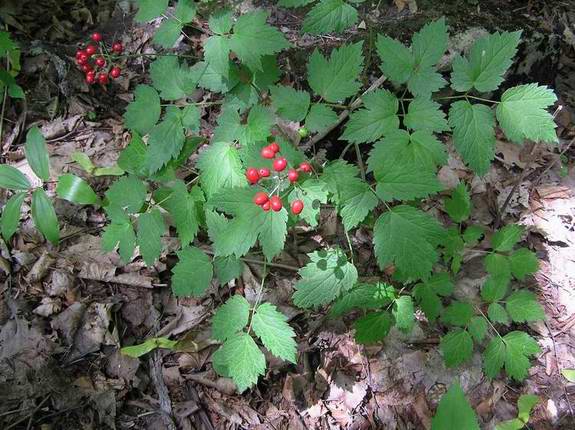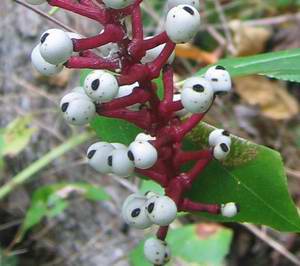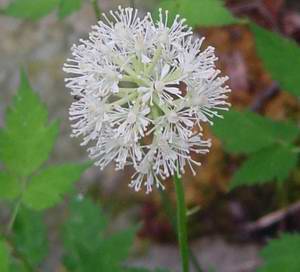|
Return to Hiker's Notebook Home Page
Common Name: Baneberry, Herb Christopher, Red cohosh, Bugbane, Toadroot, Snakeberry, Poison de couleuvre - The word 'bane' comes from the Old Norse word bani, which means slayer, its now obsolete meaning in English. In current usage, it means 'poison,' here providing a mnemonic for the toxic properties of the berry that is a bane.
Scientific Name: Actaea rubra - The genus is from the Greek word for baneberry, aktaia, with an etymological root akte which is the Greek word for the elder tree; the leaves and berries of the baneberry resemble those of the elder. The species name is from ruber, the Latin word for 'red.'
The degree of toxicity of the baneberry is open to some legitimate disputation, as there is little documentation beyond hearsay evidence of the occasionally purported fatal result of ingestion. The etiology of the belief that the plant is so poisonous as to earn the epithet of murderer (bane) is not known, though syllogism would suggest that a death occurred at some point in the relatively recent past. The name baneberry is of English provenance and refers to the species A. spicata, one of the approximately ten baneberry plants of the Northern temperate regions of the world; it is native to Europe and East Asia and is distinguished by the fact that it has black berries. The English baneberry was also known as Herb Christopher, which is thought to have derived from the hagiologic practice of assigning specific dates to a saint. The flowers of a plant that first bloomed on or near Saint Christopher's Day would then be called Herb Christopher as a mnemonic device with religious implications. A pungent smell is also attributed to the English baneberry, which supposedly attracted toads (Toadroot) but repelled insects and other vermin (Bugbane). Since it is not generally true that toads are attracted to a smell and that arthropods are repelled by it (in fact, the opposite is more likely), the common names are a tribute to the creativity of native peoples and a good example of the complexities of etymology. When the English colonists came to North America and found a shrubby plant with lobed leaves and bright red instead of black berries, they quite naturally gave it the name Red Baneberry.
The Native Americans had a different view of the baneberry. They used it primarily as a medicinal, though it had a number of other uses. It was known as Red Cohosh. The word Cohosh is from the Algonquian Indian language family; in the Massachuset language, koshki means "it is rough." The term originally referred to the gnarled root of the Black Cohosh (Actaea racemosa) and likely came to be used for a number of other plants whose roots were used medicinally, particularly in the treatment of a variety of parturition related problems . Blue Cohosh (Caulophyllum thalictroides) has a similar etymology. The root of the red baneberry was also used by various Indian tribes, notably the Ojibwa and the Potawatomi, as a treatment associated with a variety of female gender specific conditions, including menstrual cramps, postpartum pain and menopausal anomalies. The Ojibwa differentiated treatments by gender according to a now obscure method that prescribed the plant for female treatments for part of the year and to male treatments for other parts of the year.
The generally toxic nature of the red baneberry berries was well known to the Native Americans; the juice was applied to the tips of arrows to impart to them a secondary and more insidious lethality for more effective venery. As there is sometimes a fine line between a poison and a medicine (toxicity to humans vis-�-vis toxicity to the microbe or parasite targeted), the red baneberry was used on occasion as an emetic to induce vomiting and as a purgative to induce diarrhea - which generally occur in concert as the body seeks to rid itself of the deleterious substance. It was also used in the treatment of snakebite, whence the names Snakeberry and Poison de couleuvre (French for serpent poison) derive. There is some question as to the extent of this practice, since the effects of the treatment would likely be as bad or even worse than the symptoms being treated, the bite of a timber rattlesnake is rarely fatal to a healthy adult.
The toxicity of the baneberry is due to the chemical ranunculin, which is commonly found in plants of the Ranunculaceae or Buttercup Family. Ranunculin releases the toxic chemical protoanemonin enzymatically whenever the plant is damaged, such as by chewing or pulping. Protoanemonin is a skin irritant, causing erythema (redness) and blistering of the skin. On ingestion, it has a similar effect on the mucous membranes of the esophagus, stomach and intestines. The first symptoms of baneberry poisoning are accordingly blistering and burning of the mouth and throat which gradates to nausea, stomach cramps, intestinal distress and diarrhea as the toxicity proceeds by peristalsis down the digestive track. Larger doses (the cutoff is generally considered to be six or more berries) can have a more profound effect, including respiratory distress, ventricular fibrillation and cardiac arrest. There have been no reports of fatalities in the adult population though there are vague references to deaths of children in Europe, probably the ultimate source of the pejorative baneberry name. The berries are quite bitter, so it is not likely that an individual would continue to eat them after tasting one; bitterness is the telltale taste of toxicity - an evolutionary trait that protected the survivors from poisoning. Baneberry plants are occasionally consumed without apparent harm by a variety of animals including white-tailed deer, horses and sheep. The berries are eaten by birds including the robin, wood thrush and ruffed grouse and by small mammals such as mice, squirrels and chipmunks. Some birds eat the pulp and leave the seeds and some mammals eat the seeds and leave the pulp. They are of poor nutritional value.
There are nominally three species of baneberry in North America, though there
it is widely contended that the eastern and western variants of the red
baneberry, A. rubra and A. arguta, respectively, are the same
species. The USDA lists only A. rubra with a distribution that extends
from coast to coast. In some texts, A. rubra and A. arguta
are considered to be variations of the European baneberry and are accordingly
listed as A. spicata var rubra and A. spicata var
arguta. The third species, however is distinctly different, having
white berries and a much thicker pedicel - the name for the stalk that holds
the berry. The White Baneberry is indigenous only to eastern North America.
It has traditionally been known as A. pachypoda from the Latin words
for 'thick' (pachy) and 'foot' (poda) to distinguish its larger
pedicels but is also known as A. alba from the Latin word for 'white'
in recognition of its signature white berries. It also has a number of common
names that derive from its appearance. Doll's eyes is the most common
assignation, a metaphor for the singular appearance of the berries (photo by
R.
|


 Stromberg),
asserting their resemblance to the lifelike glass eyes of antique china
dolls. Since A. alba was also used by Native Americans for medicinal
purposes, it was also called White Cohosh. The names Necklace Weed and White
Beads have also been applied with obvious reference to the articles of attire
they imply. The flowers of the White Baneberry (photo by R. Stromberg) are
quite striking, though they are generally dismissed as diminutive. Closer
examination reveals that the esthetic explosion of pistils and stamens without
the concealing petals affords a striking astral appearance that calls to mind
the 'fairy candles' of the black cohosh.
Stromberg),
asserting their resemblance to the lifelike glass eyes of antique china
dolls. Since A. alba was also used by Native Americans for medicinal
purposes, it was also called White Cohosh. The names Necklace Weed and White
Beads have also been applied with obvious reference to the articles of attire
they imply. The flowers of the White Baneberry (photo by R. Stromberg) are
quite striking, though they are generally dismissed as diminutive. Closer
examination reveals that the esthetic explosion of pistils and stamens without
the concealing petals affords a striking astral appearance that calls to mind
the 'fairy candles' of the black cohosh.